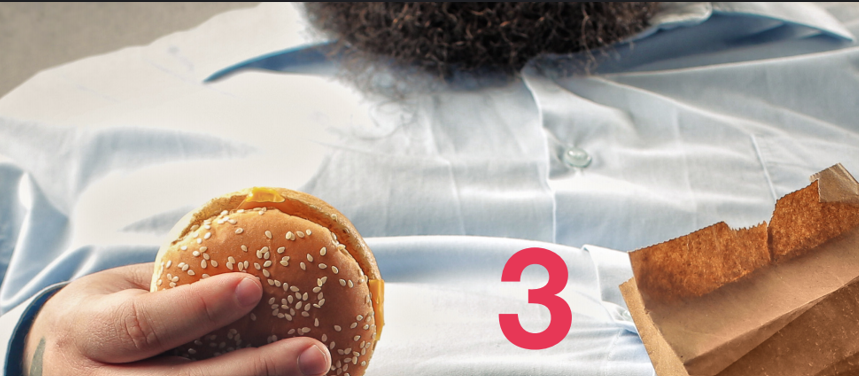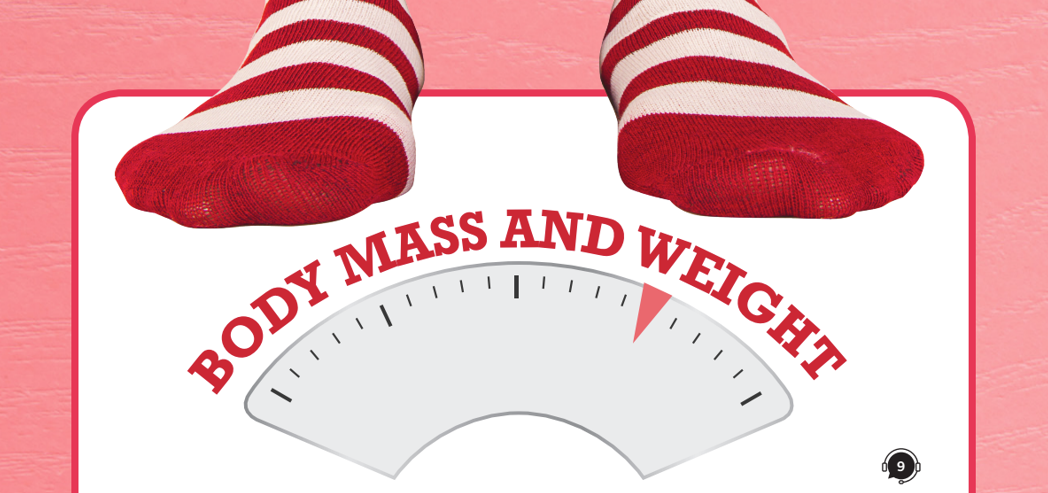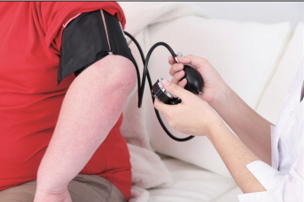
Think about the following questions.
1. What are some health problems caused by too much body fat?
2. How can you tell if someone's weight is unhealthy?
3. What do you think BMI is?
VOCABULARY PREVIEW
Match each New Academic Word List(NAWL) word with the correct definition.
- diagnose
- gauge _____
- thickness _____
- crude _____
- calculator _____
- plug into _____
- a. to put information (such as a word or a number) into something
- b. a small electronic device used for adding, subtracting, etc.
- c. simple and basic in a way that is true but not complete
- d. to identify a disease or other health condition in someone
- e. a measurement of how thick something is
- f. to measure or judge
BODY MASS AND WEIGHT

To be obese means to have too much fat on the body. Obese people are not just overweight-they are so overweight that they are likely to develop health problems. The precise1 cause of the recent rise in obesity is not clear, but it is certain that obesity is a problem in most countries. A recent study estimated2 that about forty-two percent of people in the US are obese. People need to understand what obesity is and how to tell if they themselves are obese so that they can change their condition.
An obese person does not always look extremely fat. Even people who seem only slightly overweight can be diagnosed as obese. If you have a certain percentage of fat on your body, then your health might be in danger. This is usually thought to be about forty percent of the body's total composition3.
Most people still rely on just their weight measurement to tell if they are overweight or obese, but there are problems with this method4. There are different recommended weights for different ages, and weight alone says nothing about a person's percentage of body fat, which is most important. Directly figuring out body fat percentage can be quite difficult. For example, one method requires you to squeeze5 the fat on the back of your arm, measure its thickness, and then plug this number into a formula6. However, this is only a crude estimate; a truly accurate measurement of body fat percentage requires an X-ray.
Another popular method of gauging whether someone is obese is the Body Mass Index (BMI). BMI is a person's weight in kilograms divided by the square of his or her height in meters. A normal BMI for a healthy adult is generally between twenty and twenty-five. A BMI of thirty or more means a person is obese. Many experts feel that BMI is a reliable way to determine if a person's weight is unhealthy, while others feel that BMI is too general to be really useful. The numbers come from comparisons of large groups of people. BMI is not related to an individual's body composition, so it says nothing about a person's actual percentage of body fat.
People have different body types, which can make BMI unreliable. For instance, athletes usually have more muscle mass than other people, and muscle weighs more than fat. Therefore, an athlete may have a high BMI, but this does not mean they are not healthy. Some people have higher bone density7 than others, which also increases their weight. In some cases, those who have very low body fat and are also not muscular can have a BMI that is too high. BMI is also unreliable for children and the elderly, so even supporters of BMI think that it should not be used for people under eighteen or over seventy years old.
Despite these criticisms, there are strong positive aspects of BMI. The main one is that it is very simple. The formula can be used easily and does not take special knowledge or equipment—just a scale, along with a pencil and paper or a calculator. Though BMI is a general measurement, it still gives useful information and can help identify when there might be a problem. Furthermore, some studies have shown that people with higher BMI numbers have a higher risk of health problems. It takes only a minute to get a BMI number, but the results can be very important to a person's life.
New Academic Word List
- precise 1 : adj. very accurate and exact
- estimate 2 : v. to guess
- composition 3 : n. the combination of parts or elements that make up something
- method 4 : n. a way of doing something
- squeeze 5 : v. to press together the parts and especially the opposite sides of something
- formula 6 : n. in math, a general fact or rule expressed in letters and numbers
- density 7 : n. the amount of matter in something that is shown by the relationship between its weight and its size
READING COMPREHENSION
A ‣ Mark each statement as true (T) or false (F) according to the reading.
- More than half of Americans are obese.
- True
- False
- It is easy to tell whether someone is obese by looking at them.
- True
- False
- Obesity can be defined as having at least forty percent body fat.
- True
- False
- The most precise way to measure body fat is by the thickness of arm fat.
- True
- False
- An X-ray is necessary in order to measure BMI.
- True
- False
B ‣ Choose the best answer according to the reading.
- What is the main purpose of the reading?
- a. To discuss different methods for dieting and losing weight
- b. To give examples of health problems caused by eating too much
- c. To describe the squeezing method for measuring fat percentage
- d. To explain why BMI is generally a useful method for measuring obesity
- In paragraph 4, the word it refers to _____.
- a. BMI
- b. individual
- c. body composition
- d. comparison
- Which group of people may have a high BMI but still be healthy?
- a. Obese people
- b. Very muscular people
- c. People with low bone density
- d. Most young adults
- What is an advantage of BMI over other measurement methods?
- a. It is based on the individual's body.
- b. It measures both muscle and fat.
- c. It does not require special equipment or skills.
- d. It works for all ages and body types.
C ‣ Find the correct numbers in the reading and write them on the lines.
- What is the normal BMI range for an adult?
_____ - For whom do supporters of BMI think that it should NOT be used?
_____
SUMMARY
An introductory sentence for a brief summary of the passage is given below. Choose three more sentences to complete the summary.
First Sentence: There are different methods of determining whether a person is obese.
-
- 1 muscular person weighs more because muscles are much denser than fat.
- 2 Most people still rely only on a person's weight as a method for determining obesity, although it is considered inaccurate.
- 3 The Body Mass Index (BMI) compares a person's weight with his or her height, and the resulting number is compared with that of an average person.
- 4 According to a study, about forty-two percent of Americans are considered to be obese.
- 5 Although it is not precise, the BMI still gives a person useful information about his or her body.
VOCABULARY PRACTICE
Fill in the blanks with the words in the box. Change the form if necessary.
- calculator
- crude
- diagnose
- gauge
- plug into
- thickness
- I've made a(n) _____ outline of my essay but haven't figured out the details yet.
- This time only, students will be allowed to use their _____ during the math quiz.
- When the number 3 is _____ the expression 4x2 - 2x, the result is 30.
- Thanks to the _____ of the walls in this building, we can't hear our neighbors, and they can't hear us.
- It's hard to _____ how heavy a sofa is just by looking at it.
- Millions of people are _____ with skin cancer every year, but most survive.
SUPPLEMENTAL READING
Obesity and Health

It is important to understand that obesity is not just an uncomfortable condition of the body. Obesity can cause serious health problems. Many people are not aware of these problems, so they do not try to prevent the problems before they appear. This is unfortunate since prevention is possible, though difficult.
One of the worst health problems caused by obesity is Type 2 diabetes. One study found that almost ninety percent of people with Type 2 diabetes are either overweight or obese. People with diabetes have insulin resistance, which means that their bodies do not use insulin properly. Insulin helps the body to absorb, or take in, sugar. If the body cannot absorb sugar, several bad things can result, including seizures (losing control of the body) or falling into a coma.
A number of other problems related to obesity have also been found. Obesity can cause heart disease, which is when the vessels that deliver blood to the heart become blocked. This makes it more likely that such people will suffer from heart attacks, which take place when the heart loses blood supply and cannot pump properly. Furthermore, obesity causes problems with breathing, especially when sleeping. Obese people are also at high risk for arthritis as well as certain kinds of cancers.
All of these problems, and others, can be prevented. Of course, losing weight is very difficult, and changing one's lifestyle is hard and often painful. Even so, the results of obesity are much worse.
Fill in the blanks with information from the reading.
- Because of insulin resistance, the bodies of people with diabetes cannot _____ properly.
- Obese people are especially likely to have breathing trouble when they are _____.
- Although it is difficult, the health problems caused by obesity can _____.

Leave a comment
Load more